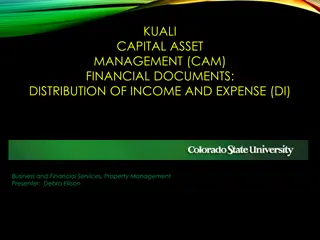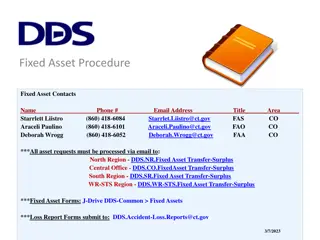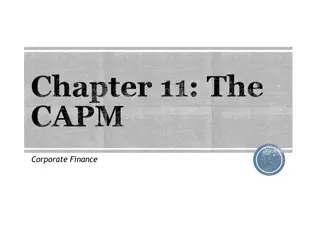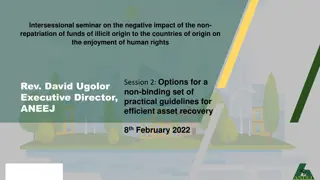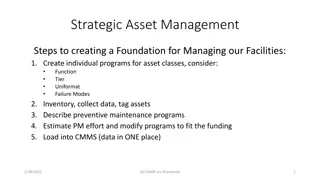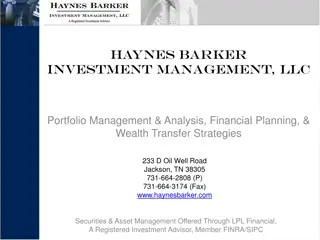Effective Asset Allocation Strategies for Investment Success
Investment professionals emphasize the critical importance of the asset allocation decision in shaping investor outcomes. Strategic Asset Allocation (SAA) focuses on long-term goals, while Tactical Asset Allocation (TAA) addresses short-term objectives. Proper navigation through economic cycles involves optimizing asset classes for stability and returns. The evolution of mutual funds offerings has led to diversified strategies like the Core-Satellite approach.
Download Presentation

Please find below an Image/Link to download the presentation.
The content on the website is provided AS IS for your information and personal use only. It may not be sold, licensed, or shared on other websites without obtaining consent from the author.If you encounter any issues during the download, it is possible that the publisher has removed the file from their server.
You are allowed to download the files provided on this website for personal or commercial use, subject to the condition that they are used lawfully. All files are the property of their respective owners.
The content on the website is provided AS IS for your information and personal use only. It may not be sold, licensed, or shared on other websites without obtaining consent from the author.
E N D
Presentation Transcript
Asset Allocation Tips Most investment professionals agree that the most important decision an investor makes is the asset allocation decision. A distinction exists between strategic asset allocation (SAA) and tactical (TAA). Usually investors refers to the SAA as the portfolio that reflects their long-term objectives. Meanwhile the TAA deviations reflect shorter-term objectives (perhaps as short as the next month). (Winkelmann 2003) 2
Navigating the Good & Bad times by SAA Different Asset Classes or Investment Strategies are Good or Bad depending on the economic regime. Finding the optimal combination of investments that diversifies risk across economic regimes is a useful way to: deliver through time stable returns (the All Wheather Solution for the SAA) & ultimately navigate through the good & bad times. (Bridgewater Associates) 3
Navigating the Good & Bad times by TAA Different Asset Classes or Investment Strategies are Good or Bad depending on the economic regime. Forecasting economic regimes and timing asset classes is a useful way to: improve the return per unit of risk through the active management of TAA deviations & ultimately navigate through the good & bad times. (Kritzman, Page, Turkington 2012) 4
SAA in practice: the evolution in mutual funds offering From GS perspective (Winkelmann 2003), there were five distinct decision points in SAA: 1. The bond/equity split, 2. The level of international diversification, 3. The level of currency hedging, 4. The level and structure of active risk, 5. The allocation to alternatives like hedge funds, private equity, real estate As every step was added to the process through time, it brought a new product to the market, reflecting the evolutionary process of mutual funds offering. Our historical experience spans traditional balanced funds and absolute return products. 5
SAA in practice: from traditional balanced funds Sample: 2003-2012 6
SAA in practice: to the absolute return approach In this process the search for efficiency mainly goes through enhancing the portfolio diversification in the cross- section dimension, by mixing different ingredients. The Core-Satellite approach For every portfolio there exists market risk ( ) and active risk ( ). Combining efficiently core market risk with unconstrained satellite active risk & alternative investments (i.e. 4th& 5thdecision points in Winkelmann 2003), where hedge funds naturally fit for satellite allocations, brought us to the Core-Satellite approach, firstly advocated by the EDHEC-Risk Institute (Amenc, Giraud, Malaise, Martellini 2004 & Amenc, Malaise, Martellini 2004). The Absolute Return approach With more portfolio diversification, projected returns get more & more stable, enticing providers to come to the market with the Absolute Return (AbR) approach: a new way of investing which aims at always achieving positive extra-returns over risk-free cash investments, regardless of markets conditions. The AbR approach has been criticized & labeled as an industry myth (Waring & Siegel 2006) In our opinion the definition is sensible, but it is very hard for any strategy to generate positive extra-returns in all market environments. Anyway, the AbR approach is defined by ESMA (the European Security & Market Authoriry): UCITS funds that are managed according to investment policies or strategies which envisage a variable allocation of the portfolio of the fund across asset classes, under the constraint of a predetermined risk limit, shall be considered as absolute return funds . 7
SAA in practice: our 1stCore-Satellite approach Our first interpretation of the AbR ran the same route: enhancing cross-section diversification with a Core-Satellite approach. The rationale was: innovative, non directional strategies do allow for new risk factors exposure and do give rise to more diversification potential. And financial innovation will keep broadening the opportunity set. We proceeded integrating market and active risk in a portfolio optimization framework: unsurprisingly optimal allocation to uncorrelated risk rises dramatically as the expected Sharpe ratio increases (Litterman 2003). 8
SAA in practice: our 1stCore-Satellite approach AbR Fund simulations: with traditional opportunity set and with the wider opportunity set 9
SAA in practice: our 1stCore-Satellite approach Designing a SAA for an AbR fund became a risk driven exercise, where diversification was applied in cross-section across the widest available opportunity set. 25% innovative t3 traditional t3 22.6% 20% 14.3% 14.6% 15% 10% 8.5% 5.6% 5.3% 5% 2.8% 2.3% 1.6% 1.1% 1.0% 0.8% 0.3% 0.1% 0.3% 0.0% 0.0% 0.1% 0.1% 0.1% 0.0% 0.0% 0% t0 6m 1YR 1.5YR 2YR 2.5YR 3YR 3.5YR 4YR 4.5YR 5YR Then, managing the AbR funds, the focus changes from active risk to total risk. The manager is accountable for the whole portfolio returns ( + ), rather than thinking about the beta as an exogenous input. 10
AbR in practice: other different interpretations & implementations The AbR approach got its birth in the stock market crash at the beginning of the decade and affirmed itself in 2008 when benchmark relative return investing got a bad name, as for final investors index- beating negative performances were still comprehensibly bad news. In real world the AbR approach encompasses different answers to a general call for something new. There is not a unique recipe for success. Every manager does leverage on his own knowledge and specialization and gives rise to a different interpretation and implementation of the AbR mandate. Investment strategy specialization gives rise to detailed clusters for the Hedge Fund* industry, where we have two main index providers: CSFB-Tremont (https://lab.credit-suisse.com/#/en/home) and Hedge Fund Research (https://www.hedgefundresearch.com/). If the investment strategy has a dynamic approach rather than a static one, then convex strategies, as long as suitable to provide portfolio insurance (see Meucci 2010), can be thought of as AbR strategies too. Then a further classification can be made: CPPI, OBPI, formula funds * is the use of investment and risk management skills to seek positive returns regardless of market direction. (Goldman Sachs & Co). What is a hedge fund? A multitude of skill-based investment strategies with a broad range of risk and return objectives. A common element 11
The 2008 test for SAA: a discontinuity in the evolution process But during the 2008 crisis the alternative strategies didn t diversify market risks, suggesting to us looking for more diversification in the core portfolio & something different instead of satellite investments. The risk analysis of the core portfolio revealed two weaknesses in the traditional approach to portfolio diversification: 1. Fixed weight market benchmarks offer a static solution to a dynamic problem (market risk follows a dynamic process), 2. A weight budgeting diversified portfolio may end up very concentrated from a risk budgeting point of view: looking at portfolio weights is not so much informative, looking at the risk decomposition is much more insightful. 12
Integrating risk & portfolio management The AbR approach puts the emphasis on positive returns generation and risk control: if risk is a dynamic process, then the AbR approach mandates a dynamic process for investments, where risk and portfolio management has to become integrated. 13
Inter-temporal diversification & vol targeting Inter-temporal diversification allows investors to optimally redistribute risks across different market regimes. AbR funds can adjust more flexibly to changes in market conditions with respect to a traditional balanced fund. Risk estimates and controls are computed weekly allowing timely trades in order to rebalance portfolio. Look at the different risk evolution of two portfolios with the same average volatility: one is vol target portfolio, the other one is a traditional balanced equity/bond portfolio with fixed benchmark weights. 14
Navigating the Good & Bad times by SAA A weight budgeting diversified portfolio may end up very concentrated from a risk budgeting point of view. A Risk Parity portfolio looks more balanced: risk diversification, not capital diversification, should be targeted as the appropriate criterion for investments allocation. 15
Navigating the Good & Bad times by TAA The key for investors is fixing their asset allocation, not trading the market well. Risk Parity is about putting equal risk on each economic scenario or risk factor to achieve balance. Anyway there are plenty or risks in risk parity portfolios (Inker 2011). Fixing the allocation is of great help to prevent traditional and non traditional risks. The investment objective is short term in nature in the AbR mandate, therefore Global Tactical Asset Allocation (GTAA Carhart 2003) becomes very relevant. The GTAA & a Multi-Strategy framework are best suited to contain market, model and active risks and deliver stable returns. 16
Asset Allocation in Good and Bad Times We look at diversification both in cross-section and inter-temporally. To get it done we explicitly envisage a flexible approach and a dynamic risk budgeting framework. Our approach to the AbR mandate can be summarized in three steps: 1. we optimize portfolios balancing risks not capital, 2. we aggregate & process active views (Meucci 2008) deviating from the neutral Risk Parity allocation, 3. Risk & portfolio management processes are integrated to better control & actively manage risks trough time. 17
References Amenc, Giraud, Malaise, Martellini 2004, The Benefits of Bond ETFs for Institutional Investors the Natural Vehicle for a Core- Satellite Approach, EDHEC Business School Amenc, Malaise, Martellini 2004, Revisiting Core-Satellite Investing a Dynamic Model of Relative Risk Management, EDHEC Business School Carhart 2003, Global tactical Asset Allocation, chapter 25 in Litterman, Modern Investment Management: an Equilibrium Approach, Wiley Dalio 2004, Engineering Targeted Return and Risk, Bridgewater Associates Working Paper Inker 2011, the Dangers of Risk parity, the Journal of Investing Kritzman, Page, Turkington 2012, Regime Shift Implications for Dynamic Strategies, Financial Analyst Journal Litterman 1996, Hot Spots & Hedges, Goldman Sachs Risk Management Series Litterman 2003, the Value of Uncorrelated Sources of Return, in Modern Investment Management: an Equilibrium Approach, Wiley Meucci 2008, Fully Flexible Views, Theory and Practice, Working Paper Meucci 2010, Review of dynamic allocation strategies: utility maximization, option replication, insurance, drawdown control, convex/concave management, Working Paper Waring and Siegel 2006, The Myth of the Absolute-Return Investor, Financial Analysts Journal Winkelmann 2003, Issues in Strategic Asset Allocation, chapter 8 in Litterman, Modern Investment Management: an Equilibrium Approach, Wiley 18




